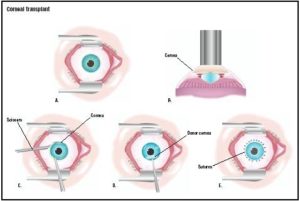Why do I need a corneal transplant?
The cornea is the clear cover on the surface of your eye. Your cornea may be cloudy, causing you to lose vision. If this is the case, a clear donor cornea should fix the problem. Your cornea can also be damaged by other diseases, infections, and injuries.
After the surgery, will I have any pain or irritation? How long will it take for these side effects to go away?
You will only have a little bit of pain and it should only last for a few days after the surgery. To control the pain, you will take painkillers. In a few cases, the stitches/sutures may break. This will irritate the eye. The sutures may need to be replaced.
How many days will I have to stay in the hospital after the cornea transplant?
This depends on the type of transplant.
- Therapeutic penetrating keratoplasty (TPK): 5 days
- Penetrating Keratoplasty (PKP): 4 days
How many days until my vision gets better?
Vision should get batter within 3 months of the surgery. If your doctor tells you to wear glasses, you will need to wear them for vision to improve.
How many months will I need to take medications?
You will need to take them for at least 6 months. Depending on the doctor’s advice, you may need to continue them past the 6 months.
When do I have to come for a follow-up?
You will need to visit your eye doctor after 1 month, 3 months, and 6 months. Sometimes, the doctor may ask you to come back more frequently.
When can I take a head bath?
Usually after 1 month. You should wait for the doctor to tell you that the wound has healed. Also, avoid bathing in river water.

